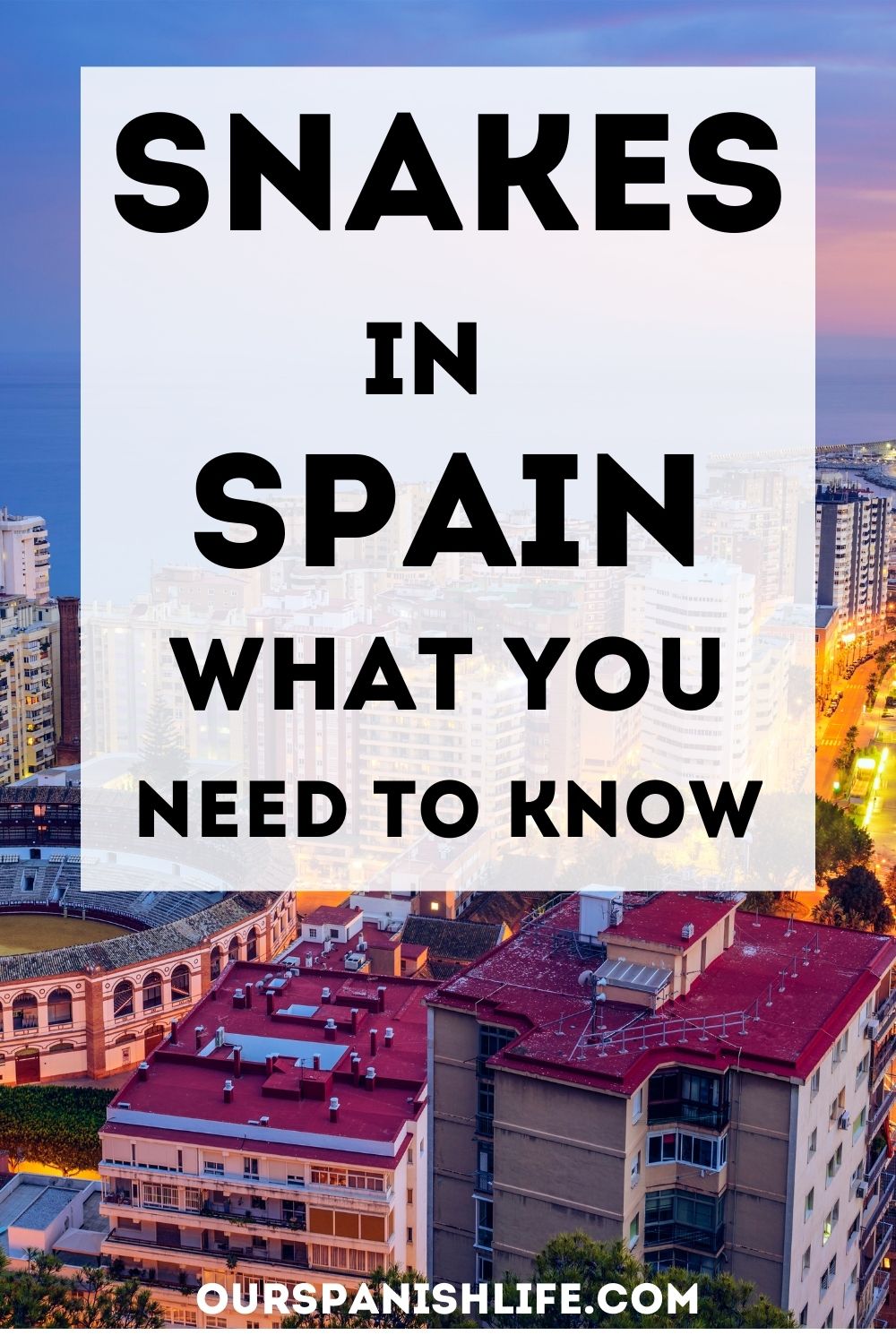As one of the world’s most popular vacation destinations, Spain is renowned for its golden, sandy beaches, sunny climate, and delicious tapas dishes.
But there can also be another side to life on the Spanish Costas and in the vibrant cities.
Various species of snake can also be found in Spain – and a number of these are highly venomous.
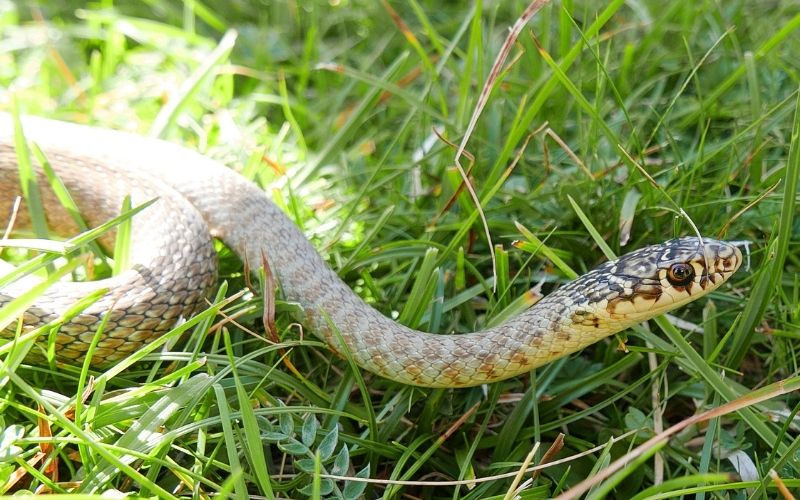
Being bitten by five of these snakes means you’ll need to seek medical attention immediately, as they are potentially fatal to human beings.
Other non-venomous snakes also reside on the sun-drenched Iberian peninsular.
This guide takes you through all you need to know about the kind of snakes that can be found in Spain.
We’ll cover which parts of Spain each can be found in, how to identify them and what you should do in the event of coming into contact with one – or even being bitten by a snake.
Snakes do have protected status in Spain, as they’re good for keeping pest numbers down. Not least rodents, which form a major part of many a snake’s diet.
As a general rule – never antagonize a snake. Even the most deadly species do, in the most part, avoid human contact, so as long as you leave it alone all should be well.
Seek medical attention immediately if you’re bitten by a snake in Spain that could be venomous, or if you experience symptoms such as fever, stiffness, vomiting, numbness, swelling, dizziness, breathing difficulties or even a loss of consciousness.
It’s always better to be on the safe side, especially if you are far from home. You could also have a previously unknown allergy to snake venom.
As the odds of a Spanish snake biting you are about 15 million to one, it’s not really ever likely to happen.
Are there snakes in Spain?
First, let’s take a look at the overall picture. Are there snakes in Spain? Yes, of course. Regions of this warm, dry land make the ideal habitat for these slithery creatures.
While there are more than ten snake species resident in Spain, there are just five very poisonous ones, so you don’t need to worry too much.
They also tend to be found throughout dry rocky areas away from major settlements. So it’s more of a concern for those venturing off the beaten track during a year in Europe than it is for the average holidaymaker.
If you want to know all about the main snakes in Spain, read on for an outline of each key species.
12 Types of Snakes in Spain
Contents
5 Most Dangerous Snakes in Spain
The following are the snakes whose paths you don’t want to cross.
While many live only in mountainous areas, they can also be found in other parts of the country, so it’s best to be vigilant.
There five dangerously venomous snake species in Spain are Seoane’s Viper, the Asp Viper, the Montpellier Snake, Lataste’s Viper and the False Smooth Snake.
The asp viper is the most dangerous of all, and the bite is very painful indeed.
An untreated bite from an Asp Viper may also be fatal.
If there’s any chance you’ve been bitten by one of these, do always seek medical attention immediately.
1. Viper of Seoane (Vipera Seoanei)
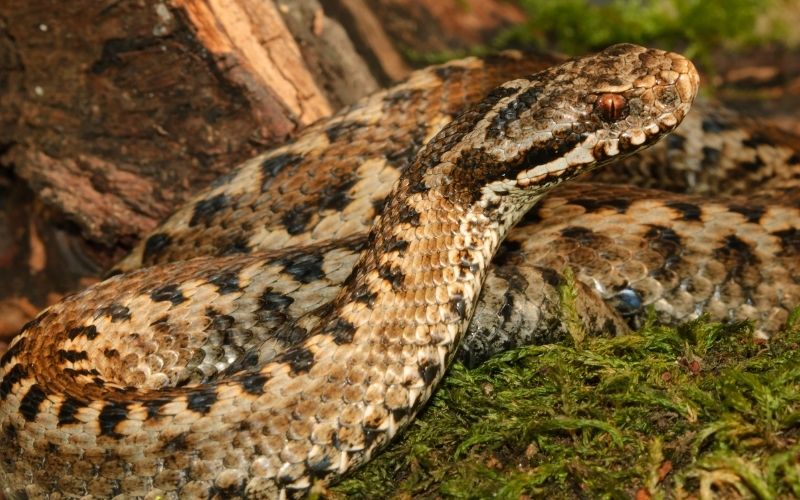
One of the first snakes in Spain you need to know about is The Viper of Seoane.
It may also be called Seoane’s viper, the Iberian cross adder or the Baskian viper. In Latin, it’s Vipera Seoane.
These vipers tend to occur in northern Spain. They are inhabit parts of south-western France and northern Portugal.
Typically, they live in and around the mountain ranges of northern Spain.
When it comes to identifying them, you should know that there are several different variations.
The first variation is characterized by distinctive brown zigzag pattern running down the back over a beige or light-gray background.
The second variation can be distinguished by two ground-colored lines that go down the length of its body, while the third variation is brown all over.
This snake is only around half a meter in length, and how venomous it is is highly regionalized.
Those from the Cantabrian mountains are thought to be the most toxic.
It’s wise to seek medical attention immediately if you are bitten by one of these, though fatalities are rare and usually restricted to the very old or very young.
2. False Smooth Snake (Macroprotodon Cucullatus)
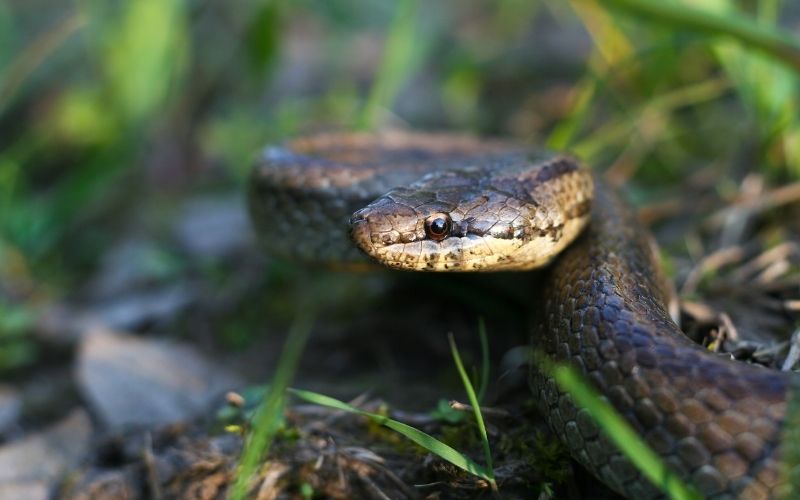
The false smooth snake also goes by a couple of other names – in Latin it’s Macroprotodon Cucullatus, and it may also be known as the hooded snake.
This type of snake is found throughout Europe, including Catalonia in northern Spain.
The good news is that due to rear fangs you’re not very likely to be struck, though it can be found in a range of habitats, including near water, in rocky areas, around shrubland and even sometimes where humans live.
The venom isn’t too poisonous to humans, but it’s always best to seek medical advice.
As well as poison, there is always the risk of infection following a snake bite. A wound may also cause considerable pain.
3. Montpellier Snake (Malpolon Monspessulanus)
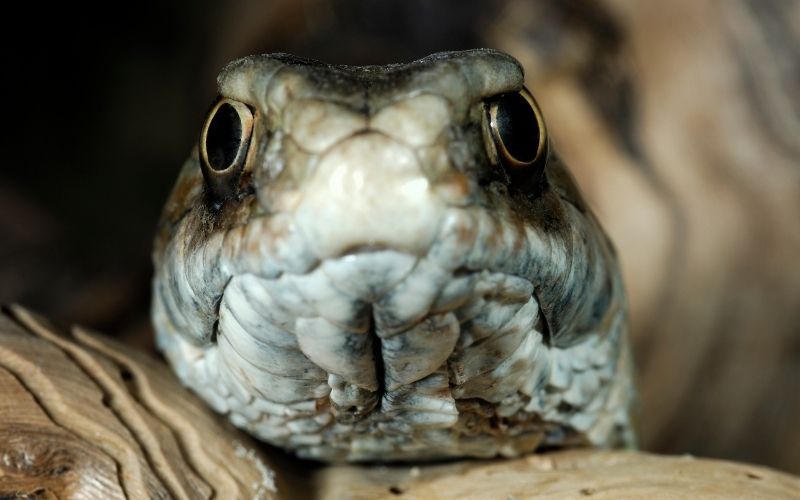
The Montpellier snake – or Malpolon Monspessalanus – is far larger than Seoane’s viper. A typical specimen is around 2 meters long – so 4 times the size.
It can be found close to river banks or in the mountains, although its preferred habitat is sandy or rocky areas.
The color varies between green, gray, brown and black, and it has a spotted pattern.
If you encounter Montpellier snakes in Spain, the warning sign is when it hisses while raising the head.
This is the time to back off, although the chance of a bite is much reduced by the fact that its fangs are at the back.
Should this snake make contact, symptoms of a bite normally present as numbness, swelling or stiffness, possibly accompanied by a fever.
4. Viper of Lataste (Vipera Latastei)
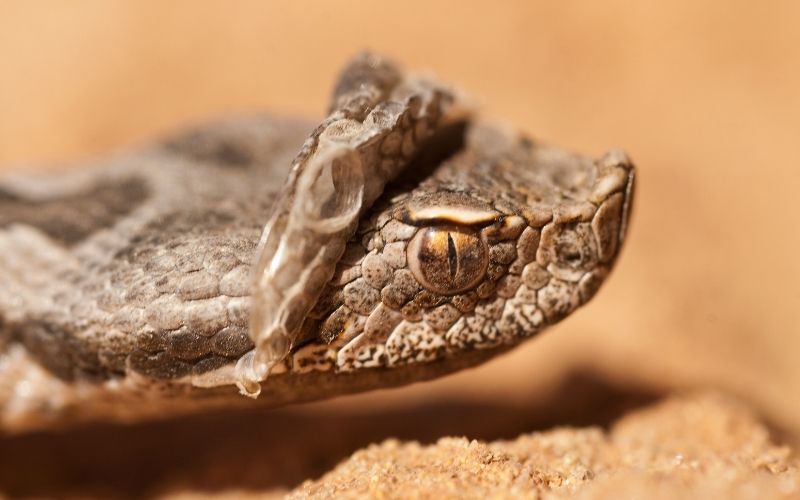
Lataste’s viper, the Viper of Lataste or Vipera Latastei is a snub nosed viper that’s easy to identify.
It has a triangular head and a dark-colored zigzag pattern, and tends to be seen when slithering out from beneath a rock.
This is a snake that likes to stay out of trouble, so unless provoked it’s unlikely to strike.
Fatalities have been known, so it’s wise to seek medical attention immediately if you are unlucky.
Frequenting the mountainous Iberian peninsula, you’re not that likely to encounter Lataste’s viper – especially as it’s a species in decline.
5. Asp Viper (Vipera Aspis)
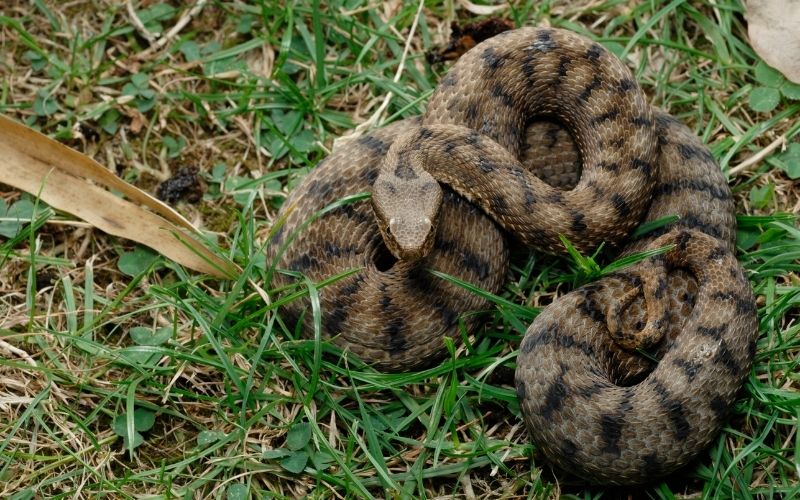
This snake species prefers to live in the Pyrenees, so unless you’re a mountaineer it’s not one to worry too much about.
It may also be known as the Viper Asp or, in Latin, Vipera Aspis.
Having said that, this is one of Spain’s most dangerous snakes, and one bite can spell curtains for the unfortunate victim.
You should certainly seek medical attention immediately if this one strikes successfully.
This snake has a triangular head and reaches around 60 to 70 centimeters in length.
The good news is that it tends to shy away from humans, so unless you go looking for trouble you should be pretty safe.
7 Less Dangerous Snakes in Spain
6. Horseshoe Whip Snake
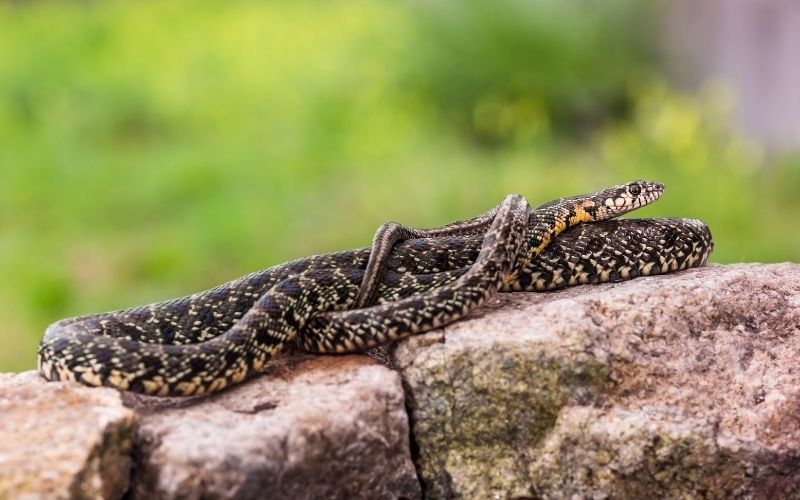
This snake is relatively harmless, and is also easy to spot thanks to its usually large head.
It’s dark in color, with a chain-type pattern on a deep brown background.
Southern Spain is where you’re most likely to come across the Horseshoe Whip snake.
7. Viperine Water Snake
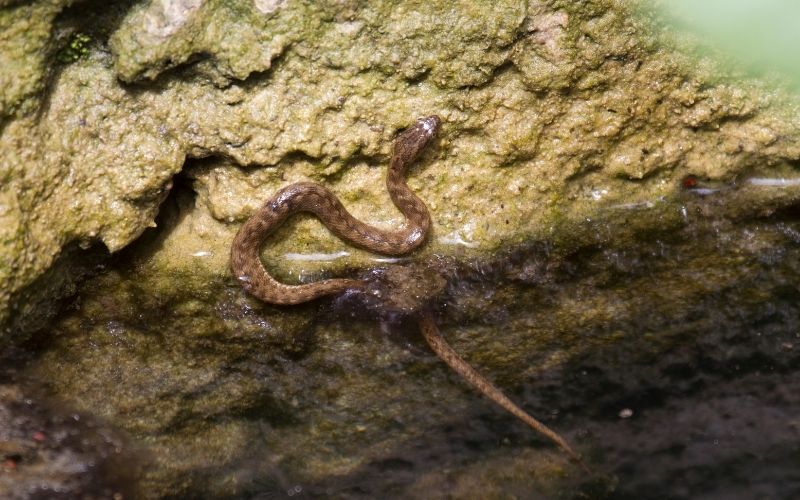
As a snake that frequents lakes and rivers, the Viperine snake or Viperine water snake is quite a common sight in some areas.
Despite being known as a viper, this harmless snake isn’t one to worry about.
8. Ladder Snake
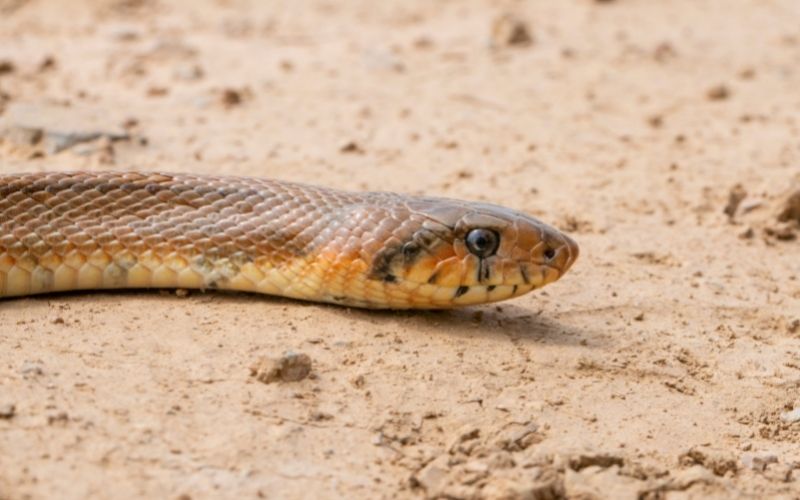
This species is found all over Spain.
Although they may attack if provoked – and who could blame them – all you should end up with is a fairly painful bite.
9. Aesculapian Snake

The Aesculapian Snake is indigenous to only the far north of Spain.
Although their 2 meter length makes them a jaw-dropping sight, they’re pretty innocuous.
10. Southern Smooth Snake
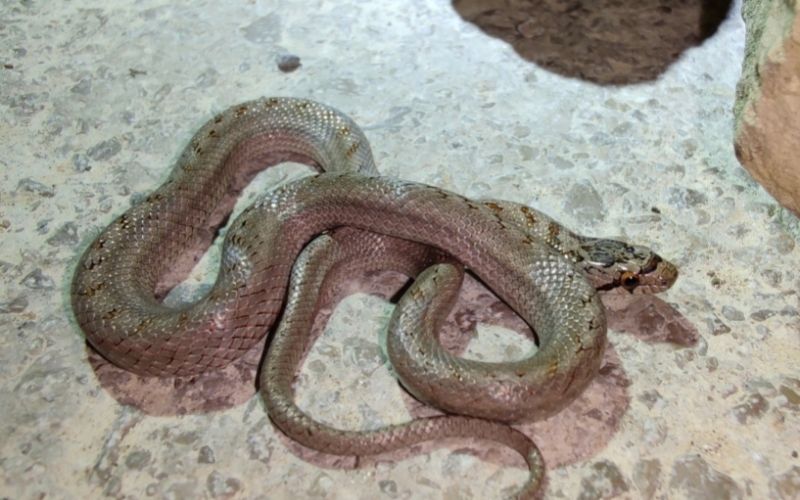
As the name suggests, this slithery creature lives in southern parts of Spain, as well as North Africa.
The average one is a little over half a meter long.
11. Western or Green Whip Snake
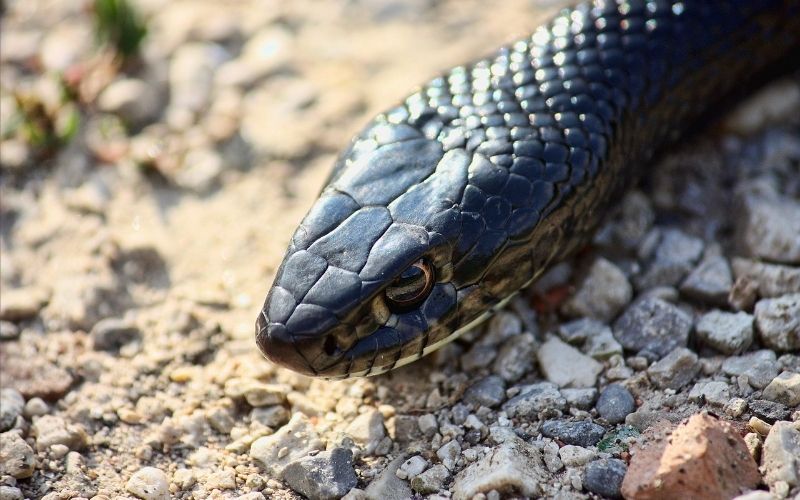
This snake is unusually distinctive, but although the lime green coloring may look alarming it’s a pretty inoffensive fellow.
Just as well, perhaps, as it’s even seen in urban areas from time to time.
12. Grass Snake
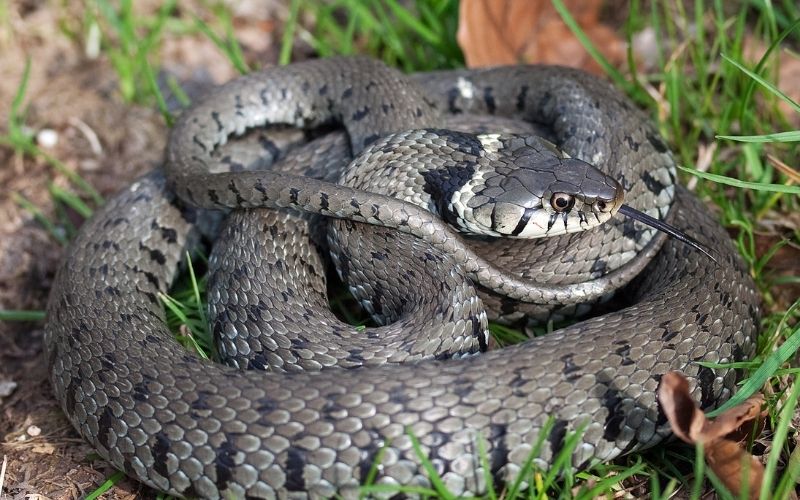
Grass snakes are seen all over Europe, even in countries like the UK.
This species loves fresh water, so may be spotted in or around rivers and lakes throughout Spain.
Snakes in Spain – FAQs
How common are snakes in Spain?
Only a handful of snake bites occur each year in Spain, so it’s not something to worry about too much.
In fact the creatures are pretty widespread in Spain, but they tend to stay away from people. Most live in areas removed from humans, particularly where there are mountains.
Does Spain have any venomous snakes?
Spain has five snakes you to know about if you are concerned. These are the Viper of Seoane, the False Smooth Snake, the Viper of Lataste, the Montpellier Snake and the Asp Viper.
The latter is the most dangerous to humans. This triangular headed reptile is most often found in the Pyrenees.
Does Spain have a lot of snakes?
There are around a dozen snake species in Spain, so not really that many. Five of them are highly toxic to humans, so they’re the ones to watch out for.
Although there are snakes all over Spain, then tend to shy away from human contact. Most, if unprovoked, will leave people alone, so if you do spot one it’s wise to back off!
Are there snakes on the Costa del Sol?
As the Costa del Sol forms part of Andalusia, there are some southern snakes you could come across, especially in less inhabited areas.
The three to look out for are the Horseshoe whip snake, the Montpellier snake or the Ladder snake, particularly in rocky areas.
Are there snakes in Benidorm?
Unless you visit the right kind of wildlife centre, you’re unlikely to cross paths with a snake in Benidorm or on the Costa Blanca.
Only those who venture up into the hills or wilderness may wish to wear long pants, just to be on the safe side. You can also familiarize yourself with the dangerous species before heading out.
What should I do if bitten by a snake?
If you are unlucky enough to be the victim of a snake attack, the first thing to do is to get away from the area as quickly as possible.
This is case there are more snakes present. If the bite occurred in water, you may need to help the victim onto dry land.
As long as it’s safe, the person who’s been bitten should stay as still and calm as they can. Extra movement means the venom can circulate around the body more rapidly.
Never rub or wash the affected area. Nor should you apply pressure bandages, ice packs or heat.
Call for medical assistance as soon as it is safe to do so. If you need to, use the recovery position, and never leave the victim unattended.
If you can, use a splint to immobilize the affected limb. As swelling is likely, remove any restrictive garments or jewelry that could inhibit blood circulation. Never use a tourniquet.
Where there is a pen to hand, mark where the bite occurred.
This may help medical professionals during treatment. Also ask the victim to describe the snake, if they saw it, in case they lose consciousness.
If you do take or give out pain relief, stick only to mild paracetamol. Avoid the consumption of caffeine, alcohol or other stimulants.
Snakes in Spain – The Bottom Line
Unless you stray far from tourist areas without a guide, snakes in Spain are unlikely to be of any concern.
The chance of being bitten by a snake is so minimal, especially if you back off in the event of spotting one!
Related:
- 7 Dangerous Spiders in Spain to Be Aware Of
- 32 Essentials for Your Spain Packing List
- Do You Need 6 Months on Your Passport to Travel to Spain?
